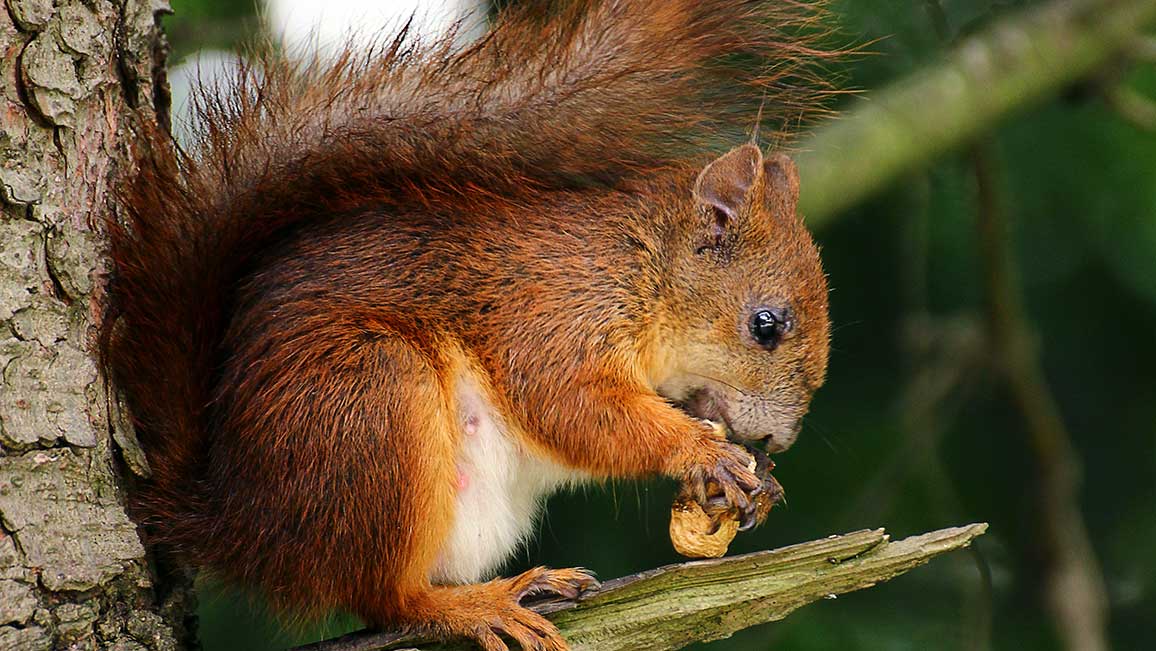
Red Squirrels
By Ellen Lambeth; photos by Heidi & Hans-Jürgen KochIn Europe, red squirrels need—and get—a helping hand.
Who’s that above, with the fluffy, tufted ears? It’s a Eurasian red squirrel, checking the scene outside its tree hole. Don’t confuse this little squirrel with the red squirrel of North America. That species has no ear tufts. And this one lives in forests across Europe and northern Asia (see map).
Nearby is trouble (above right). It’s a gray squirrel—an invader from the eastern half of the United States. How did it get so far from home, and how does it cause trouble for the red squirrels? Let’s backtrack a bit, and soon you’ll see.
The History
Like many other animals around the world, Eurasian red squirrels have had their share of problems. Their forest homes have been cut down for lumber and to make way for roads, towns, and farms. Of course, that means fewer trees to live in and less food for the squirrels. It also means that there are many more pet dogs and cats around to chase and catch the tiny squirrels. To make matters worse in some areas, gray squirrels are making themselves right at home. And they don’t make good neighbors.
It all started a long time ago, when people took some gray squirrels from America over to Europe, and several got loose. These outsider squirrels moved into the shrinking forests and quickly grew in number. Now the grays are spreading across Europe and causing more trouble for the native reds.
Above top is a red squirrel protection station in Germany. People rescue sick or hurt red squirrels and treat them here until they are well. They also rescue abandoned babies and hand-raise them here.
The young squirrel (above) had been attacked by a crow. Now recovering at the rescue station, it gets a gentle cleaning with a toothbrush.
The bunch of babies top right fell out of their nest when their tree was cut down. (As you can see, red squirrels come in colors other than red.) After their rescue, the orphans are raised by hand and fed milk with an eyedropper (above right).
The Trouble
Red and gray squirrels are alike in many ways. They both prefer big trees, where they can find places for nesting and seeds for eating. The trees are also great for avoiding hungry predators on the ground.
But gray squirrels are nearly twice the size of red squirrels. That means they have less trouble with predators, which find it easier to go after the little guys. Gray squirrels also eat more than reds. And they have more babies—and more often. In no time, gray squirrels can take over a forest, leaving less food and nesting places for the red squirrels.
It gets even worse: Gray squirrels carry a disease. This disease doesn’t seem to bother the grays much. But when it spreads to red squirrels, it becomes deadly. So, as you can guess by now, gray squirrels are doing Great in Europe, while red squirrels may be in danger of dying out.
When the rescued squirrels are ready, they’re released into the protection station’s “halfway house” at far left. Here, they practice climbing and finding food on their own till it’s time to go free. Still hanging on to the open door of its crate, the little guy at bottom left is checking out its new digs in the “halfway house.” Soon, it will work up the courage to leap right in. The rescued babies above right are now old enough to show off their tufted ears and meet the outside world for the first time.
The Solution
Groups of people in some parts of Europe—such as England, Italy, and Germany—are working hard to help their native “tufties.” One way is by trying to keep gray squirrels out of the places where red squirrels live. Another way is by saving more forests for red squirrels in places where grays aren’t yet a problem. A third way is by teaching the local people about their “little reds.” The more people know about red squirrels and their problems, the more support these groups get in their work to protect them. In several places around Europe, there are even special red squirrel protection stations. People who work at these stations help keep the native squirrel numbers up by rescuing any orphaned, sick, or injured reds they find. They take care of these “patients” until they’re big enough and strong enough to take care of themselves.
It’s a lot of work. But, for every squirrel that gets a second chance, the work is well worth it!
“Red Squirrels” originally appeared in the November 2010 issue of Ranger Rick magazine.
(Click on each image above for a closer view of the story.)



















